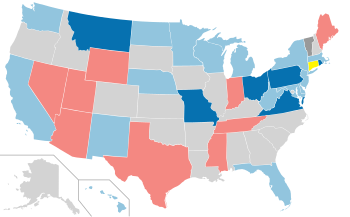
Back ھەڵبژاردنی ئەنجومەنی پیرانی ئەمریکا (٢٠٠٦) CKB Wahlen zum Senat der Vereinigten Staaten 2006 German Élections sénatoriales américaines de 2006 French 2006년 미국 상원의원 선거 Korean Pilihan raya Senat Amerika Syarikat 2006 Malay Wybory senackie w Stanach Zjednoczonych w 2006 roku Polish
| |||||||||||||||||||||||||||||||||||||||||||||||||||||||||||||||||||||||||||||
33 of the 100 seats in the United States Senate 51 seats needed for a majority | |||||||||||||||||||||||||||||||||||||||||||||||||||||||||||||||||||||||||||||
|---|---|---|---|---|---|---|---|---|---|---|---|---|---|---|---|---|---|---|---|---|---|---|---|---|---|---|---|---|---|---|---|---|---|---|---|---|---|---|---|---|---|---|---|---|---|---|---|---|---|---|---|---|---|---|---|---|---|---|---|---|---|---|---|---|---|---|---|---|---|---|---|---|---|---|---|---|---|
| |||||||||||||||||||||||||||||||||||||||||||||||||||||||||||||||||||||||||||||
 Results of the elections: Democratic gain Connecticut for Lieberman gain Democratic hold Republican hold Independent hold No election
| |||||||||||||||||||||||||||||||||||||||||||||||||||||||||||||||||||||||||||||
| |||||||||||||||||||||||||||||||||||||||||||||||||||||||||||||||||||||||||||||
The 2006 United States Senate elections were held on November 7, 2006, with all 33 Class 1 Senate seats being contested. The term of office for those elected in 2006 ran from January 3, 2007, to January 3, 2013. Before the election cycle, the Republican Party controlled 55 of the 100 Senate seats.
The Senate elections were part of the Democratic sweep during the 2006 elections, in which Democrats made numerous gains and no congressional or gubernatorial seat held by a Democrat was won by a Republican.[1] However, Democratic incumbent Joe Lieberman in Connecticut was defeated in the primary and was later reelected as a third-party candidate; he continued to caucus with the Democrats. Because of this, this is the first time since 1970 in which a member of a third party, who is not an independent, was elected to the Senate. Independent Jim Jeffords in Vermont retired but was succeeded by another Independent, Bernie Sanders, retaining their presence in the Senate. Jeffords and Sanders both caucused with Democrats. Democrats picked 6 seats up by defeating Republican incumbents in Missouri, Montana, Pennsylvania, Ohio, Rhode Island, and Virginia, while holding open seats in Maryland and Minnesota. Republicans held their sole open seat in Tennessee.
Following the elections, no party held a majority of seats for the first time since January 1955. The Democrats were able to control the chamber because the two Independents caucused with the Democrats. They needed at least 51 seats to control the Senate because Vice President Dick Cheney would have broken any 50–50 tie in favor of the Republicans. This was the only time between 1990 and 2022 that Democrats gained Senate seats in a midterm.
As of 2023[update], this was the last time a Democrat won a Senate election in Nebraska, the last time a Democrat did not win a seat in Connecticut, and the last time that the tipping point state was decided by under 1%, with Jim Webb of Virginia winning by a margin of under .4%.
- ^ Don Rose (December 26, 2006). "Democratic sweep may be long-lasting". Chicago Tribune. Retrieved April 9, 2014.

